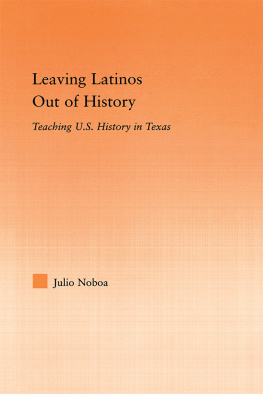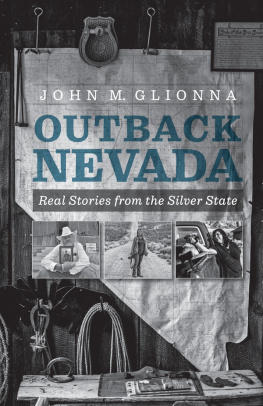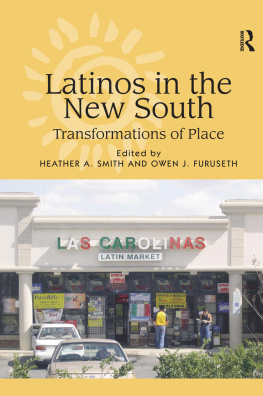
Migration, Demography & Environmental Change: Global Challenges
Series Editors: Tiffiany Howard and Nerses Kopalyan
With nationwide population increases driven primarily by recent immigrants and their children, the United States is currently ranked as the third most populous country and has the highest population growth of all the industrialized nations. Of particular significance is that contemporary migratory patterns have altered the countrys demographics to such an extent that it is projected ethnic and racial minorities will comprise a majority of the U.S. population by 2042. Migration, Demography & Environmental Change: Global Challenges promotes works that investigate U.S. migration and population change as these factors relate to the fields of political science, public policy, history, ethnic studies, environmental affairs, sociology, anthropology, education, public health and the health sciences, as well as legal studies.
Latinos in Nevada: A Political, Economic, and Social Profile
John P. Tuman, Tiffiany Howard, David F. Damore, and Nerses Kopalyan
The publication is funded in part by a grant from Nevada Humanities and the National Endowment for the Humanities.
Migration, Demography & Environmental Change : Global Challenges Series
Series Editor: Tiffiany Howard and Nerses Kopalyan
University of Nevada Press, Reno, Nevada 89557 USA
Copyright 2021 by University of Nevada Press
All rights reserved
LIBRARY OF CONGRESS CATALOGING-IN-PUBLICATION DATA
Names: Tuman, John P. (John Peter), 1964 author. | Howard, Tiffiany, author. | Damore, David F., 1970 author. | Kopalyan, Nerses, author.
Title: Latinos in Nevada : a political, economic, and social profile / John P. Tuman, Tiffiany Howard, David F. Damore, Nerses Kopalyan.
Description: Reno : University of Nevada Press, [2021] | Series: Migration, demography & environmental change : global challenges series | Includes bibliographical references and index. | Summary: Latinos in Nevada: A Political, Economic, and Social Profile provides a political, economic, and demographic profile of contemporary Latinos in Nevada. Adopting an interdisciplinary perspective, the authors examine Latino history, growth, and trends in employment, education, and health, and analyze the dynamics of political participation and civic engagement Provided by publisher.
Identifiers: LCCN 2020045090 (print) | LCCN 2020045091 (ebook) | ISBN 9781948908986 (paperback) | ISBN 9781948908993 (ebook)
Subjects: LCSH: Hispanic AmericansNevadaPolitics and government21st century. | Hispanic AmericansNevadaEconomic conditions21st century. | Hispanic AmericansNevadaSocial conditions21st century. | Hispanic AmericansNevadaHistory. | NevadaEmigration and immigration.
Classification: LCC F850.S75 T86 2021 (print) | LCC F850.S75 (ebook) | DDC 979.3/0046800905dc23
LC record available at https://lccn.loc.gov/2020045090
LC ebook record available at https://lccn.loc.gov/2020045091
Manufactured in the United States of America
25 24 23 22 21 5 4 3 2 1
Illustrations
Figures
Maps
Tables
Acknowledgments
This book grew out of a research project directed by John P. Tuman and David F. Damore, and supported by Brookings Mountain West, a partnership between the Brookings Institution in Washington, DC, and UNLV. Parts of chapters , is adapted and updated from Tuman (2009). His study of Latino civic and political engagement was funded by the Woodrow Wilson International Center for Scholars.
We would like to acknowledge our former students Maria Jos Flor greda, David Snyder, and Samantha Burtch for research assistance. Professor Jaewon Lim also assisted with analysis of the public use microdata samples (PUMS) on interstate migration. In addition, we thank two anonymous reviewers for their extensive comments on the completed manuscript, and Clark Whitehorn, former executive editor of the University of Nevada Press, for helping to bring this book to fruition. We are also grateful for the support of JoAnne Banducci in procuring a Nevada Humanities publication grant, and the assistance of Sara Vlez Mallea, Sara Hendricksen, and Iris Saltus, all with the University of Nevada Press. Paul Szydelko, our copyeditor, provided useful comments that enhanced the quality of the book. The university community has also provided a great deal of support along the way. In particular, we are thankful to our colleagues in the Department of Political Science and the Liberal Arts Deans Office. Finally, we thank our families for support.
CHAPTER 1
IntroductionA History
The Southwest region of the United States has had a Hispanic presence for more than 400 years. Historical accounts reveal a long history of Hispanic settlement in the region that began with the establishment of the Spanish colonial territory of New Spain in 1521. And two years later, in 1850, with the first US Census that provided detailed household information, we began to have data confirming the enduring and impactful presence of Hispanics and Latinos in the Southwest, and specifically in the territory that would later become the state of Nevada.
Origins of Nevadas Early Hispanic/Latino Population
Critics and supporters of the term Hispanic ascribe varied meanings to the word. In New Mexico and other parts of the Southwest, many embrace the term Hispano (Hispanic in Spanish) as a term of ethnic identification. Many of those who reject the words usage often associate it with the colonial power of Spain and its enslavement and oppression of the native indigenous population in the region. Thus, contemporary references to this group exhibit a preference for the usage of the term(s) Latino/a/x. contextualize its general meaning, as well as its intended meaning for the purposes of this work.
At its most basic level, Hispanic refers to the collective identity of a people with direct ethnic, sociocultural, and linguistic linkages to Spain, and by extension the Spanish-speaking countries of Latin America and the Caribbeanbut excluding that of Brazil, Haiti, and all other non-Spanish speaking countries in the region. Ethnically, Hispanics are predominantly descended from the unions between indigenous Americans and early Spanish settlers. At the same time, a combination of the substantial presence of African Moors in Spain, several of whom took part in early Spanish expeditions, and the burgeoning African slave trade that began in the 1440s, has contributed to the further diversification of the Hispanic ethnic identity. As a result, Hispanics may be purely European, Indigenous, or African, a combination of two of the three groups, or a blend of all three.
Socioculturally, Hispanics reflect cultural traditions inherited from the Iberian Peninsula that were altered and transformed by the influences of indigenous and African traditions, and developed in the Americas. While no group is monolithic and there will always be variations in religious traditions, the majority of Hispanics maintain religious affiliation to the Roman Catholic Church. Finally, the primary unifier among Hispanics is the Spanish language, although the dialect varies across regions.
Mining, Ranching, and Hispanic/Latino Settlement in Nevada
Hispanic and Latino settlers established homesteads on the sites of mining discoveries in several areas in Nevada. Many of these places are easily identified in the historical record by their Spanish-origin names. In the early 1800s, the town of Montezuma was established and mined by Spaniards, and later by Mexicans. Montezuma was near Goldfield, in what is now Esmeralda County. The town was abandoned in the mid-1800s, but American miners settled there after the discovery of gold and silver in 1867.











